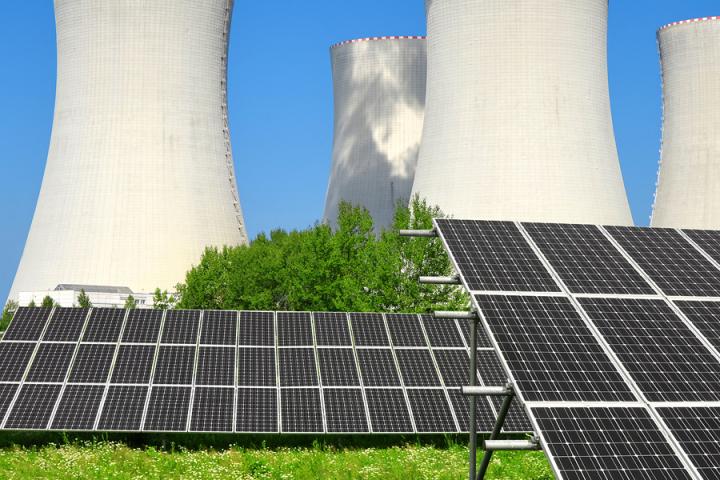Balancing nuclear and renewable energy

Power plants that balance nuclear and renewable energy could increase revenues from electricity markets and reduce variable operating and maintenance costs, according to Argonne scientists. Credit: Vaclav Volrab and Argonne National Laboratory
Researchers from the U.S. Department of Energy's (DOE) Argonne National Laboratory and the Massachusetts Institute of Technology recently explored the benefits of doing just that. If nuclear plants generated power in a more flexible manner, the researchers say, the plants could lower electricity costs for consumers, enable the use of more renewable energy, improve the economics of nuclear energy and help reduce greenhouse gas emissions.
The new study “gives us tools to further explore potential benefits of flexible nuclear operations to work in tandem with greater shares of variable sources of renewable power generation …” — Jesse Jenkins, graduate researcher at the MIT Energy Initiative
The team explored technical constraints on flexible operations at nuclear power plants and introduced a new way to model how those challenges affect how power systems operate. “Flexible nuclear power operations are a 'win-win-win,' lowering power system operating costs, increasing revenues for nuclear plant owners and significantly reducing curtailment of renewable energy,” wrote the team in an Applied Energy article published online on April 24.
Audun Botterud, a principal energy systems engineer in Argonne's Energy Systems division, is encouraged by how, for the first time, “this research evaluates and demonstrates the potential value of flexible nuclear operations in a realistic power system in the United States challenged by high variability in renewable-energy generation.”
The study helps to dispel long-held views that nuclear power plants must operate in “baseload” mode, producing power at maximum rated capacity whenever they are online. Nuclear plants can even respond dynamically to hourly electricity market prices and second-to-second frequency regulation needs, the team found. Power systems that include renewable energy must be more flexible to balance supply and demand at all times. Nuclear operators in France, Germany and other countries are familiar with this approach, but less so in the United States.
The researchers developed a mathematical representation of the physics-induced operational constraints arising from nuclear reactor dynamics and the fuel irradiation cycle in the Applied Energy article and a companion paper, published in Nuclear Technology. The interdisciplinary team then combined the new approach with power system simulation models to evaluate the overall cost of electricity generation, market prices and resulting revenues for power plants, assuming different levels of nuclear flexibility.
“Nuclear power plants are governed by a different set of principles compared to other generators, and our approach enables the representation of these relationships in the analysis of power systems and electricity markets,” said Francesco Ganda, the principal investigator of the project and a principal nuclear engineer in Argonne's Nuclear Science and Engineering division.
By being flexible, plant operators can lower overall operating costs in the power system. For example, operators could generate less nuclear power whenever renewable energy is widely available. Nuclear plants could then exploit their spare capacity to sell valuable “operating reserves,” or the ability to quickly change power output to help grid operators rebalance supply and demand when unexpected events occur, such as power plant failures or errors in demand forecasts.
This flexibility could increase the profitability of nuclear plants by increasing revenues from electricity markets and reducing variable operating and maintenance costs. Overall, nuclear plant flexibility can also help integrate more wind and solar resources and reduce production of fossil fuel-fired energy and related carbon dioxide emissions.
Jesse Jenkins, graduate researcher at the MIT Energy Initiative, notes how the researchers' modeling approach and study “gives us tools to further explore potential benefits of flexible nuclear operations to work in tandem with greater shares of variable sources of renewable power generation on the pathway towards low-carbon electricity supply.”
Other Argonne study authors include Richard Vilim, Zhi Zhou and Roberto Ponciroli. The research was funded, in part, by Argonne's Laboratory Directed Research and Development program.
Argonne National Laboratory seeks solutions to pressing national problems in science and technology. The nation's first national laboratory, Argonne conducts leading-edge basic and applied scientific research in virtually every scientific discipline. Argonne researchers work closely with researchers from hundreds of companies, universities, and federal, state and municipal agencies to help them solve their specific problems, advance America's scientific leadership and prepare the nation for a better future. With employees from more than 60 nations, Argonne is managed by UChicago Argonne, LLC for the U.S. Department of Energy's Office of Science.
The U.S. Department of Energy's Office of Science is the single largest supporter of basic research in the physical sciences in the United States and is working to address some of the most pressing challenges of our time. For more information, visit the Office of Science website.
Media Contact
All latest news from the category: Power and Electrical Engineering
This topic covers issues related to energy generation, conversion, transportation and consumption and how the industry is addressing the challenge of energy efficiency in general.
innovations-report provides in-depth and informative reports and articles on subjects ranging from wind energy, fuel cell technology, solar energy, geothermal energy, petroleum, gas, nuclear engineering, alternative energy and energy efficiency to fusion, hydrogen and superconductor technologies.
Newest articles

Long-sought structure of powerful anticancer natural product
…solved by integrated approach. A collaborative effort by the research groups of Professor Haruhiko Fuwa from Chuo University and Professor Masashi Tsuda from Kochi University has culminated in the structure…

Making a difference: Efficient water harvesting from air possible
Copolymer solution uses water-loving differential to induce desorption at lower temperatures. Harvesting water from the air and decreasing humidity are crucial to realizing a more comfortable life for humanity. Water-adsorption…

In major materials breakthrough
UVA team solves a nearly 200-year-old challenge in polymers. UVA researchers defy materials science rules with molecules that release stored length to decouple stiffness and stretchability. Researchers at the University…



